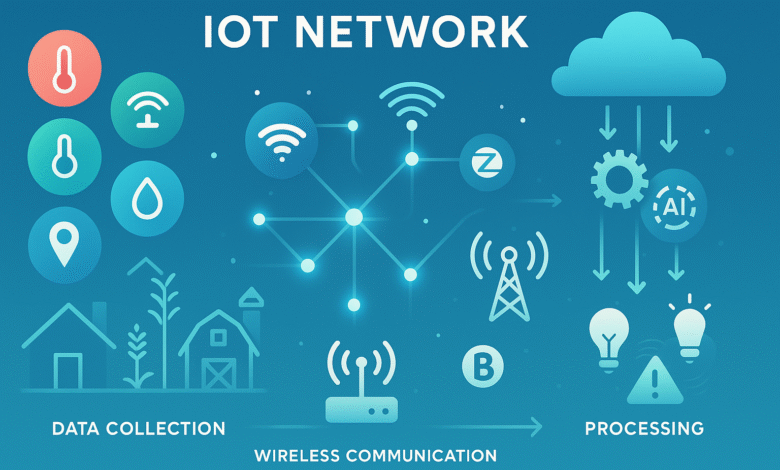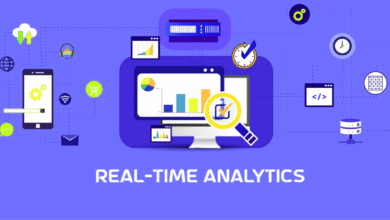How IoT Networks Work: The Complete Guide
Learn how IoT networks work, connecting smart devices and sensors for real-time data transmission, processing, and automation across industries.

Imagine your refrigerator texting your phone when milk runs low, or your factory machines talking to each other to fix problems on their own.
That’s the power of how IoT networks work.
The Internet of Things has changed our world by connecting everyday devices to the internet so they can share information without people having to do anything.
Today, there are billions of IoT devices working together right now, sending data and making smart decisions. Whether it’s your smartwatch, a farmer’s soil moisture sensor, or a hospital’s patient monitor, IoT technology is making life easier and helping businesses save money.
Understanding how IoT networks work helps you see why they matter and what makes them so special.
What Are IoT Networks?
An IoT network is a system where smart devices and IoT sensors connect together using the internet to share information. Think of it like a group chat for objects instead of people. These networks link everything from your home thermostat to industrial machines in factories.
The key idea is that devices can talk to each other and exchange data without anybody telling them to do it. When you turn off your lights with your phone from across the city, that’s an IoT network at work. The devices collect information about their surroundings, send that information somewhere safe for processing, and then take action based on what they learn.
IoT networks are growing incredibly fast. With billions of connected devices already deployed around the world, IoT systems have become part of everything we do—from our homes to our jobs to our cities.
How IoT Networks Work: The Four-Step Process
IoT networks work through a simple but powerful four-step cycle. Let’s break down each part:
Step 1: Data Collection with IoT Sensors
Everything starts with IoT sensors. These small devices sit in the real world and watch for changes. They measure things like temperature, humidity, light, motion, sound, and even location. Sensors are the eyes and ears of IoT systems.
For example, a farmer might use IoT sensors in a field to check soil moisture. A factory might use sensors to watch machine pressure. A smart home uses IoT sensors to detect whether a door is locked. These sensors are cheap, lightweight, and use very little power.
When a sensor notices a change, it wakes up and prepares to send data. This is the first and most important step in how IoT networks work.
Step 2: Data Transmission Through Wireless Networks
Once sensors collect data, it needs to travel somewhere. This is where wireless networks and connectivity come in. There are many ways IoT devices can send information:
- WiFi networks – Fast and common, but uses more power
- Bluetooth – Good for short distances and low power
- Zigbee – Perfect for home automation
- Cellular networks – Reaches anywhere phones work
- LoRaWAN – Long-range and super low power
Different IoT applications need different wireless connectivity options. A smartwatch might use Bluetooth connectivity, while a remote farm sensor might use LoRaWAN because it only needs to send small updates once a day.
The choice of network technology is crucial to how IoT networks work successfully.
Step 3: Data Processing in Cloud and Edge Computing
After data travels through a wireless network, it arrives at a hub or server for processing. This happens in two main ways:
Cloud Computing: Data travels to a big data center somewhere on the internet. Powerful computers store the information, analyze it, and look for patterns. This works great when you want to store lots of information and run complicated analysis.
Edge Computing: Data gets processed nearby, at a local device called a gateway or hub. This happens faster because the information doesn’t have to travel as far. Edge computing is better when you need super-quick responses.
Most IoT systems use both. Your smart thermostat might process simple decisions at home (edge), while sending all your data to the cloud for long-term tracking.
Step 4: Automated Actions and Responses
Here’s where the magic happens. After processing the data, the IoT network decides what to do. This usually happens automatically, without people having to do anything.
A few examples:
- If a factory sensor detects high temperature, it might automatically turn on a cooling system
- If a home security sensor detects motion, it might send an alert to your phone and turn on lights
- If a hospital patient monitor detects an irregular heartbeat, it might alert a doctor immediately
Machine learning and artificial intelligence help IoT systems make smarter decisions. They learn from patterns in the data and get better over time.
Different Types of IoT Networks and Wireless Technologies
Not all IoT networks work the same way. Choosing the right wireless network technology is essential for IoT projects. Let’s look at the main options:
WiFi Networks for IoT
WiFi is probably the most familiar wireless technology. It’s fast and already in most homes and offices.
Good things about WiFi:
- Very fast data transmission (up to 10 Gbps)
- Wide coverage in most buildings
- Easy to set up if you already have WiFi
- Works well for cameras and devices that need to send lots of information
Challenges with WiFi:
- Uses a lot of power, so batteries drain quickly
- Limited range compared to other options
- Security can be tricky if not set up properly
- Gets crowded when many devices use it at once
WiFi works best for IoT devices that stay in one place and don’t mind using more power.
Bluetooth and Bluetooth Low Energy
Bluetooth, especially the newer Bluetooth Low Energy (BLE) version, was designed for mobile and wearable devices.
Advantages of Bluetooth:
- Extremely low power consumption
- Perfect for smartwatches and fitness trackers
- Short-range communication is more secure
- Already built into most smartphones
Limitations:
- Shorter range than WiFi (usually 30-100 meters)
- Can’t send as much data per second
- Works best for simple information like temperature readings
About 25% of all connected IoT devices in the world use Bluetooth connectivity today, especially in consumer products.
Zigbee and Mesh Networks
Zigbee is a wireless technology built specifically for home automation and industrial uses. It creates what’s called a mesh network.
In a mesh network, every device can pass along information to other devices, like a relay race. If one device stops working, others pick up its signal. This makes mesh networks very reliable.
Benefits of Zigbee:
- Uses very little power
- Creates reliable networks
- Works well in homes and small factories
- Doesn’t cost much to set up
Drawbacks:
- Smaller range than WiFi or cellular
- Requires special equipment
- Less well-known than WiFi
Cellular and Long-Range Networks
For devices that need to work anywhere, cellular networks (4G, 5G, LTE) are the answer. These are the same networks that phones use.
There are also special long-range, low-power networks like:
- LoRaWAN – Can send data up to 20 kilometers in open areas
- NB-IoT – Cellular network specifically for IoT devices
- Sigfox – Another long-range, low-power option
Why choose cellular networks:
- Coverage almost everywhere
- Fast, reliable connection
- Good for devices that move around
- Perfect for emergency alerts
Challenges:
- Monthly costs
- Uses more power than some alternatives
- Requires contracts with carriers
Also Read: 5G Network Infrastructure: Enabling Ultra-Low Latency IoT Applications
Key Components That Make IoT Networks Work
Every IoT system needs certain parts to function. Here are the critical components:
1. IoT Sensors and Devices
Sensors are the foundation of every IoT network. They collect information about the environment. Modern IoT sensors can measure:
- Temperature and humidity
- Motion and vibration
- Light and sound
- Air quality
- Water quality
- Pressure and force
- Location using GPS
These sensors are often combined into smart devices like thermostats, security cameras, and health trackers.
2. IoT Gateways and Hubs
An IoT gateway is like a translator and manager. It collects information from IoT sensors and devices, understands what it means, and decides where to send it next. Without a gateway, sensors would just broadcast random information with nowhere to go.
IoT gateways sit between the wireless network and the cloud or local system, making sure everything understands each other.
3. Connectivity Infrastructure
Wireless networks and connectivity technologies are the highways that move information around. Different types serve different needs:
- WiFi for homes and offices
- Cellular networks for mobile devices
- Zigbee for smart homes
- LoRaWAN for wide areas
- Ethernet for wired connections when needed
4. Data Processing Platforms
Platforms that store and analyze IoT data are absolutely necessary. They handle millions of sensor readings and turn raw numbers into useful information. These platforms can run in the cloud or locally on edge devices.
5. Machine Learning and AI
Smart IoT systems use machine learning to understand patterns. Over time, these systems learn to predict problems before they happen and make better decisions without human help.
Real-World Applications of IoT Networks
IoT networks are already solving real problems in every industry:
Smart Homes
Smart home systems use IoT devices and sensors to control lights, temperature, locks, and appliances. You can adjust everything from your phone. These systems learn your habits and make your home more comfortable and energy-efficient.
Healthcare and Medical Monitoring
Hospitals use IoT networks to monitor patients continuously. Wearable sensors track heart rate, blood pressure, and oxygen levels. IoT systems alert doctors instantly if something changes. This saves lives.
Agriculture and Precision Farming
Farmers deploy IoT sensors throughout fields to check soil moisture, temperature, and nutrients. IoT devices help farmers:
- Water crops exactly when needed
- Reduce waste
- Increase yields
- Monitor large areas from home
Manufacturing and Industry
Factories use IoT networks to watch machines work. Industrial sensors detect problems before equipment breaks. This cuts downtime and maintenance costs dramatically.
Smart Cities
IoT networks help cities work better by:
- Controlling traffic lights for smoother traffic flow
- Detecting parking spaces in real time
- Monitoring air and water quality
- Managing street lights automatically
Energy and Utilities
IoT sensors on power lines and in homes help utility companies understand how energy moves through the system. Smart meters track energy use minute by minute, helping people and companies save money.
Challenges in IoT Networks and How to Overcome Them
Security Concerns
With billions of connected devices, security is crucial. Hackers could try to:
- Steal information from sensors
- Take control of IoT devices
- Break into IoT networks
Solutions:
- Encryption to protect data while traveling
- Strong passwords and authentication
- Regular software updates
- Careful network design
Interoperability Issues
Different IoT devices from different companies sometimes can’t talk to each other. They use different languages (protocols).
Solutions:
- Industry standards like Matter are being developed
- IoT platforms that translate between different protocols
- Manufacturers working together on common standards
Power Consumption
Batteries in remote sensors can’t last forever.
Solutions:
- Bluetooth Low Energy and LoRaWAN use very little power
- Solar-powered sensors
- Devices that harvest energy from their environment
- Efficient wireless connectivity options
Data Management
IoT networks create massive amounts of information every second.
Solutions:
- Edge computing processes data locally
- Cloud storage and analysis for long-term trends
- Smart filtering to ignore unimportant data
The Future of IoT Networks
IoT networks are just getting started. Here’s what’s coming:
5G and Beyond: Super-fast, low-latency cellular networks will enable new IoT applications we can barely imagine today.
Artificial Intelligence: IoT systems will become smarter, predicting problems and making better decisions automatically.
Sustainability: New wireless technologies will use even less power, making IoT devices work for years on a single battery.
Security First: Better encryption and security standards will make IoT networks safer.
Edge Computing Growth: More processing will happen locally on IoT devices, making systems faster and more private.
Integration: IoT networks will become invisible—built into everything from clothing to roads.
Getting Started with IoT Networks
If you’re interested in IoT technology, here’s what you should know:
- Understand your needs – What problem are you trying to solve?
- Choose the right wireless technology – Different IoT applications need different approaches
- Select an IoT platform – Many companies offer platforms to manage connected devices
- Start small – Begin with a pilot project before going big
- Keep security in mind – Protect your IoT system from the start
For more detailed technical information about IoT platforms, check out IBM’s comprehensive IoT guide, which covers enterprise IoT solutions and cloud architecture. You can also learn about specific wireless protocols and network design in TechTarget’s IoT agenda, where industry experts explain advanced IoT concepts and implementations.
Conclusion
IoT networks work by connecting smart devices and sensors that collect data, transmit it through wireless networks, process it using cloud or edge computing, and then take automatic actions—all without people having to do anything. From smart homes that learn your habits to factories that fix themselves, IoT technology is making the world smarter and more efficient.
The basic process is simple: collect data with IoT sensors, send it through a network, analyze it with smart software, and take action automatically. As more devices connect to the internet and wireless technologies get better, IoT networks will become even more important to how we live and work.
Understanding how IoT networks work helps you see the opportunity in this connected world, whether you’re building smart products, managing factories, or just curious about the technology around you. The Internet of Things is no longer the future—it’s happening right now, making our lives easier one connected device at a time.











